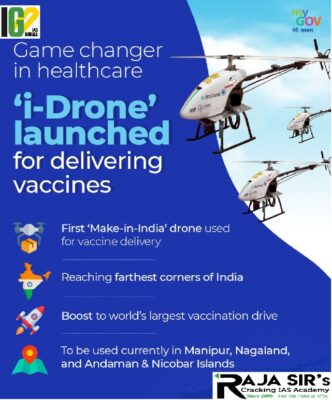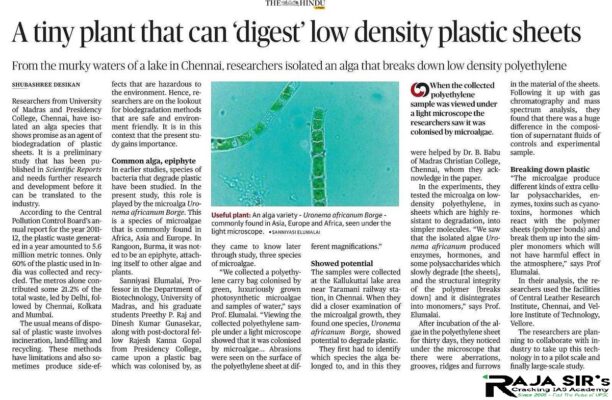- Home
- Prelims
- Mains
- Current Affairs
- Study Materials
- Test Series
 EDITORIALS & ARTICLES
EDITORIALS & ARTICLES
06th Oct 2021
EXPLAINED: THE 2021 NOBEL PRIZE IN PHYSIOLOGY OR MEDICINE
This 2021 Nobel for Medicine was awarded jointly to David Julius and Ardem Patapoutian, both of the United States, for their discoveries of receptors for temperature and touch.
Highlights:




- Nobel Prize for Physiology or Medicine is awarded for significant discovery in life science or medicine.
- Karolinska Institute (now The Nobel Assembly at Karolinska Institute) selects the winner.
- The award comes with a gold medal and 10 million Swedish kronor (over $1.14 million).
- The prize money comes from a fund left by Swedish inventor Alfred Nobel, who died in 1895.
- The scientists have won the Nobel for their discoveries of receptors for temperature and touch.
- The discoveries have allowed understandinghow heat, cold and mechanical forces can initiate the nerve impulses that enable us to perceive and adapt to the world around us.
- Dr Julius studied the different compounds in chilli peppers and spider venom to understand how our bodies sense heat and chemical irritants.
- Decoding theneuroscience of pain can help develop new targets for pain therapy.
- Dr Patapoutian helped discover a novel class of sensors in our skin and internal organs that respond to cold and other mechanical stimuli.
- In 1997, Dr Julius and his team published a paper detailing how capsaicin (the chemical compound in chilli peppers) causes the burning sensation.
- They created a library of DNA fragments to understand the corresponding genes and finally discovered a new capsaicin receptor and named it TRPV1.
- This discovery paved the way for the identification of many other temperature-sensing receptors.
- Both Dr Julius and Dr Patapoutian identified another new receptor called TRPM8, which is activated by cold.
- This new receptor is specifically expressed in a subset of pain-and-temperature-sensing neurons.
- Dr. Patapoutian further studied if mechanical stimuli can activate these receptors.
- They identified a single genethat, when silenced, made the cells insensitive to the poking. They named this new mechanosensitive ion channel
- This knowledge of the TRPV1, TRPM8 and Piezo channels is being used to develop treatments for a wide range of disease conditions, including chronic pain.
- Chronic pain is present in several illnesses and disorders. With the understanding of these receptors, it is possible to gain the ability to regulate them to minimise the pain.
- Currently, the drone-based delivery project has been granted permission for implementation in Manipur and Nagaland, as well as Andaman and Nicobar Islands.

- This i-Drone has been designed to overcome the challenges of geographical diversities by deploying Unmanned Aerial vehicles (UAV)/drones to remote areas and hard to reach terrains.
- This is for the first time that a ‘Make in India’ drone has been used in South Asia to transport COVID vaccine over an aerial distance of 15 km in 12-15 mins.
- The actual road distance between these locations is 26 km.
- Telangana launched Beyond Visual Line of Sight (BVLoS) flights to deliver a payload comprising vaccines.
- The Medicine from the Sky project — a collaboration of the Telangana government, World Economic Forum, HealthNet Global and NITI Aayog — seeks to deliver medicines, vaccination, and units of blood to remote, rural areas by means of drones.
- The Raksha Mantri gave away awards to 40 winners - 22 in Individual category and 18 in Startup category and launched ‘Dare to Dream 3.0’.
- Dare to Dream is DRDO's pan-India contest to promote Indian academicians, individuals and startups to develop emerging defence and aerospace technologies/systems.
- It has been launched on the 5th Death Anniversary of Dr APJ Abdul Kalam, who had a vision of self-reliance.
- Objective: To unearth disruptive ideas and concepts in emerging technologies identified by DRDO for enhancing defence capabilities.
- The scheme is being launched for emerging technologies to promote the individuals & start-ups for innovation in defence and aerospace technologies.
- It is an open challenge to promote the country’s innovators and start-ups
- DRDO provides technical and financial support to the winners for realisation of their ideas under the Technology Development Fund (TDF) scheme.
- A cash award of:
- Up to 10 lakhs for Start-ups
- 5 lakhs for individuals
- The day was observed to honour the lost children and survivors of the country's indigenous residential schools, families, and communities.
- It aims to educate and remind the citizens of the history of indigenous children and remember their suffering. The citizens were encouraged to wear orange colour.
- 140 government-run Residential Schools were operating in Canada for indigenous children between 1831 and 1998, with the last school shutting down about 23 years ago.
- The children were forcefully separated from their families and not allowed to acknowledge their culture or speak their languages.
- The schools were overcrowded, underfunded and offered a poor standard of education. The education was limited to imparting practical skills.
- The girls were only taught to do domestic chores such as sewing, laundry, cooking and cleaning.
- Boys were only taught skills such as carpentry and farming.

- This species of microalgae found in Africa, Asia, and Europe.
- It is an epiphyte, attaching itself to other algae and plants.
- The microalgae produce different kinds of cellular polysaccharides, toxins such as cyanotoxins, hormones.
- The polysaccharides react with the polymer sheets and break them into simpler monomers which do not have harmful effect in the atmosphere.
- Trishul is a group of three Himalayan Mountain peaks of western Kumaon, with the highest (Trishul I) reaching 7120 m.
- The three peaks resemble a trident in Hindi, ‘Trishula’ a weapon of Lord Shiva.
- The group forms the southeast corner of the ring of peaks enclosing the Nanda Devi Sanctuary.
- The three peaks are Trisul I, Trisul II, and Trisul III. The group is a north-south ridge, with Trisul I at the north end and Trisul III at the south.
- It runs through North-South, and appears compressed when viewed from the south.
- It is a solemn duty of a teacher to instil discipline in the students. It is not uncommon that teachers reprimand a student for not being attentive or not being up to the mark in studies or for bunking classes or not attending the school.
- A mere reprimand or disciplinary action will not translate to the crime of abetment of suicide unless “there are repeated specific allegations of harassment and insult deliberately without any justifiable cause or reason”.
- A simple act of reprimand of a student for his behaviour or indiscipline by a teacher, who is under moral obligation to inculcate the good qualities of a human being in a student, would definitely not amount to instigation or intentionally aid to the commission of a suicide by a student.
- It was not only the moral obligation of a teacher but also his “legally assigned duty” under Section 24 (e) of the Right of Children to Free and Compulsory Education Act, 2009 to hold regular meetings with the parents and guardians and apprise them of the regularity in attendance, ability to learn, progress made in learning and any other act or relevant information about the child.
- The case concerned the death of a 14-year-old by suicide in Rajasthan in 2018. The appellant, a teacher, was accused of ‘insulting’ the boy, a student in the same school.
- Abetment to Suicide is an offence under Section 306 of Indian Penal Code (IPC), 1860.
- A person is accountable for abetment to suicide when any of the following conditions are fulfilled:
- He/ She instigates someone to commit suicide.
- He/ She takes part in a conspiracy to make a person commit suicide.
- He/ She helps the victim deliberately so he can commit suicide by doing an act or not doing something that he was bound to do.
- If any person commits suicide, whoever abets the commission of such suicide shall be punished with imprisonment of either imprisonment for a term which may extend to ten years, and shall also be liable to fine.
- Abetment of suicide is an offence tried in a Sessions court and is cognizable, non-bailable and non-compoundable in nature.
- Cognizable offence: A police officer can make an arrest without a warrant from a court.
- Non-bailable offence: Bail is granted to the accused at the discretion of the court, and not as a matter of right.
- Non-compoundable offence: The case cannot be withdrawn by the complainant even when the complainant and the accused have reached a compromise. The court will not allow withdrawal of a case involving a non-compoundable offence.
- Aim: To create world-class infrastructure for the business needs of the local artisans & SMEs to boost production and export.
- This scheme will provide infrastructural support, market access, design, and technology up-gradation to handicrafts artisans.
- The focus will be on integration of scattered artisans, linking them to SMEs in the handicrafts sector to ensure economies of scale.
- Integrated projects will be taken for the development through Central/State Handicrafts Corporations.
- The scheme will continue up to March 2026.
- To provide requisite support in terms of infrastructure, product diversification, design development, marketing and promotion, social security.
- To create livelihood opportunities through specific intervention in the industry and to increase the income of the artisans engaged in this sector.
- The small handicrafts units and poor artisans are inadequate to undertake the initiatives due to non-availability of proper infrastructure and common facilities.
- To overcome these challenges, it is necessary to form a Public-Private Partnership (PPP) model to create clusters with necessary facilities to meet the industry needs.
- The artisans will be provided with margin money of Rs. 4000 to complete one cycle of production-cum-marketing within three months.
- Provision of Trade Center, Exhibition Hall, Customs office, etc. will be provided.
- There is a proposal for the establishment of a raw material bank for continuous availability of graded raw material
- It will improve the share of the cluster products in domestic as well as export markets through exhibitions, buyer-seller meets, retail space, warehouses, etc.
- It seeks to improve productivity and quality; training will be provided on technical skills.
- The artisans will be covered under social security schemes, which includes small savings, group insurance, financial institutions, etc.









 Latest News
Latest News General Studies
General Studies